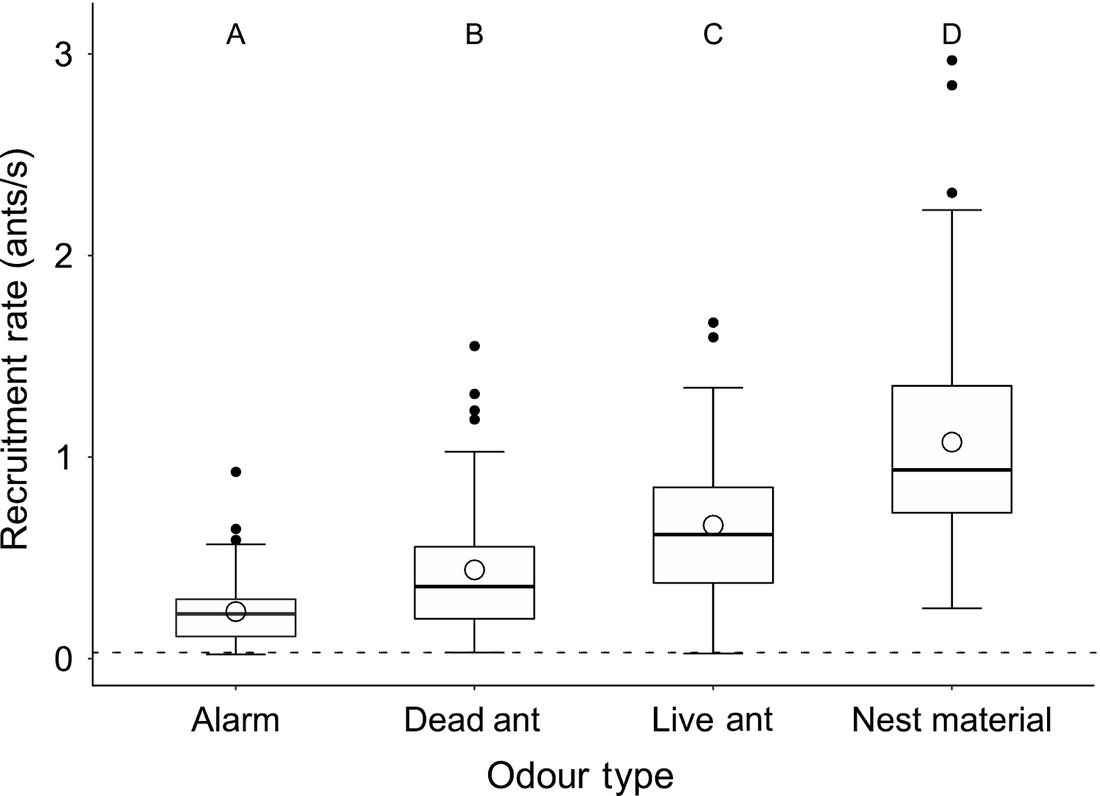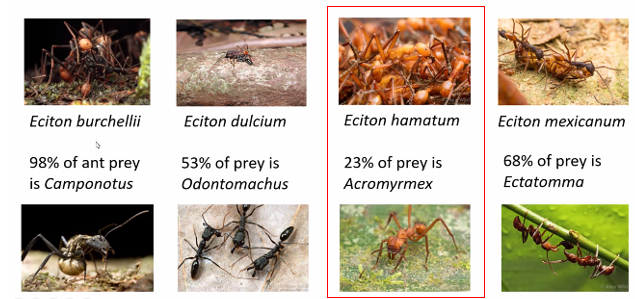[Seminar Blog] All for one and one for all, Dietary specialization in neotropical army ants3/28/2022
Ants are a highly diverse family of social insects with a global distribution. There are about 10,000 species of ants worldwide. Here in the USA, we may be colloquially familiar with carpenter or fire ants but these represent only a small fraction of North American ant diversity. Army ants comprise about 150 species of ant in the New World. They are social insects, with a dicthadiigyne or permanently wingless queen, and each nomadic colony can contain hundreds of thousands of individuals. They are largely blind and primarily use their sense of smell to hunt for food. Fascinatingly, Neotropical army ants are specialized predators of other ants, and they forage in large groups called raids. Raids are composed of members of a single colony, hundreds of thousands strong, which allows the colony to consume a surprising number of arthropods daily. With all of these ants eating other ants in any given area of the forest, the question arises as to how this is ecologically sustainable. Why doesn’t the competition between all these different species lead to the extinction of species that may be less fit to survive in this ant-eat-ant world? Simply put, niche partitioning through diet specialization encourages different species to feed on different types of organisms, which reduces competition and fosters co-existence. An inquisitive Dr. Manubay aimed to discover the mechanism behind prey selection that leads one species of army ant to recognize and eat different prey than another species of army ant. His research and recent publication have helped scientists better understand the dietary specialization and prey detection of Neotropical army ants. Dr. Manubay and his colleagues used a conspicuous species of army ant, Eciton hamatum (Fig. 2), to test the hypothesis that New World army ants use odors to find their preferred prey. E. hamatum has a dietary specialization on Acromyrmex leaf-cutter ants, specifically their brood (Fig. 2). They aimed to answer questions about E. hamatum prey odor detection such as their ability to detect prey odors while foraging in nature, their ability to differentiate between ant species based on odor, and to quantify any differentiated predatory responses based on a variety of prey odor cues. Research took place on Barro Colorado Island (BCI), Panama in the summer of 2015. Four odor treatments of both prey and non-prey ant species that consisted of (1) alarm pheromones from contactless living ants, (2) cuticular hydrocarbons (CHC) from freshly killed ants, (3) CHCs, alarm pheromones, and vibration from directly contacted living ants, and (4) general colony odor and concentrated CHCs from the nesting material. Small masses of material emitting these odors were placed ahead of advancing fronts of E. hamatum raids, and any changes in the behavior of the ants in response to the odor cues were assessed. They analyzed the recruitment rate (Fig. 4) and mean individual running speeds of ants encountering different prey odor types and found that E. hamatum were most interested in CHC-rich odors that are more strongly associated with the nests and brood of prey ants. When faced with nest material from ants they do not typically feed on, E. hamatum army ants did not exhibit any significant change in walking speed or recruitment of other foraging army ants. However, nest material from prey ants incited a much stronger response, causing foragers to immediately slow down and recruit their sister ants. These behaviors are typical of army ants encountering prey items.  Figure 4. Rate at which E. hamatum army ant foragers recruit other raiding foragers in response to varying types of odorant material from prey ant species. Greater recruitment rates are observed in response to odors more closely associated with their preferred food, the brood of prey ant species, as well as with odors containing higher concentrations of signature cuticular hydrocarbons (Manubay and Powell 2020). Do all Eciton army ants follow this same pattern? Eciton burchellii ants are somewhat unique within the genus, with roughly half of their diet being large non-ant arthropods, and the other half being only a single ant genus. If these army ants use olfactory cues similar to E. hamatum, they would likely need to recognize and identify all the odors associated with their diverse range of large-bodied arthropod prey, from cockroaches to katydids to scorpions. This led Dr. Manubay to predict that E. burchellii use less specific cues, such as the mechanical movement and vibration of a struggling arthropod, to identify their prey. Sure enough, they found that E. burchellii showed a greater recruitment rate and decrease in walking speed in response to moving non-prey ants than E. hamatum. Additionally, when faced with living and dead katydids, E. burchellii foragers showed much greater interest in living, moving prey. All of this indicates that E. burchellii rely more heavily on mechanical vibration as a cue for detection of their non-ant prey.
Dr. Manubay and his team’s discoveries surrounding the different sensory mechanisms at play behind prey detection in different species of Neotropical army ants give us a better idea of how these fascinating organisms operate. With this knowledge, scientists can better understand how army ants partition resources and avoid competitive exclusion in an ant-eat-ant world. References Manubay, J.A. and Powell, S. (2020) Detection of prey odours underpins dietary specialization in a Neotropical top-predator: How army ants find their ant prey. J. Anim. Ecol. 89:1165–1174. https://doi.org/10.1111/1365-2656.13188 Powell, S. and Franks, N.R. (2006) Ecology and the evolution of worker morphological diversity: a comparative analysis with Eciton army ants. Functional Ecology 20: 1105-1114. http://www.jstor.org/stable/4139349. Authors Maggie Hartman is a M.S. student in the Lamp Lab at the University of Maryland. She studies community composition and diet of dragonflies and damselflies in Maryland agroecosystems. Alireza Shokoohi is a M.S. student in the Lamp Lab at the University of Maryland currently studying ground beetle ecology within agricultural drainage ditch ecosystems. Comments are closed.
|
Categories
All
Archives
June 2024
|
Department of Entomology
University of Maryland
4112 Plant Sciences Building
College Park, MD 20742-4454
USA
Telephone: 301.405.3911
Fax: 301.314.9290
University of Maryland
4112 Plant Sciences Building
College Park, MD 20742-4454
USA
Telephone: 301.405.3911
Fax: 301.314.9290




 RSS Feed
RSS Feed




